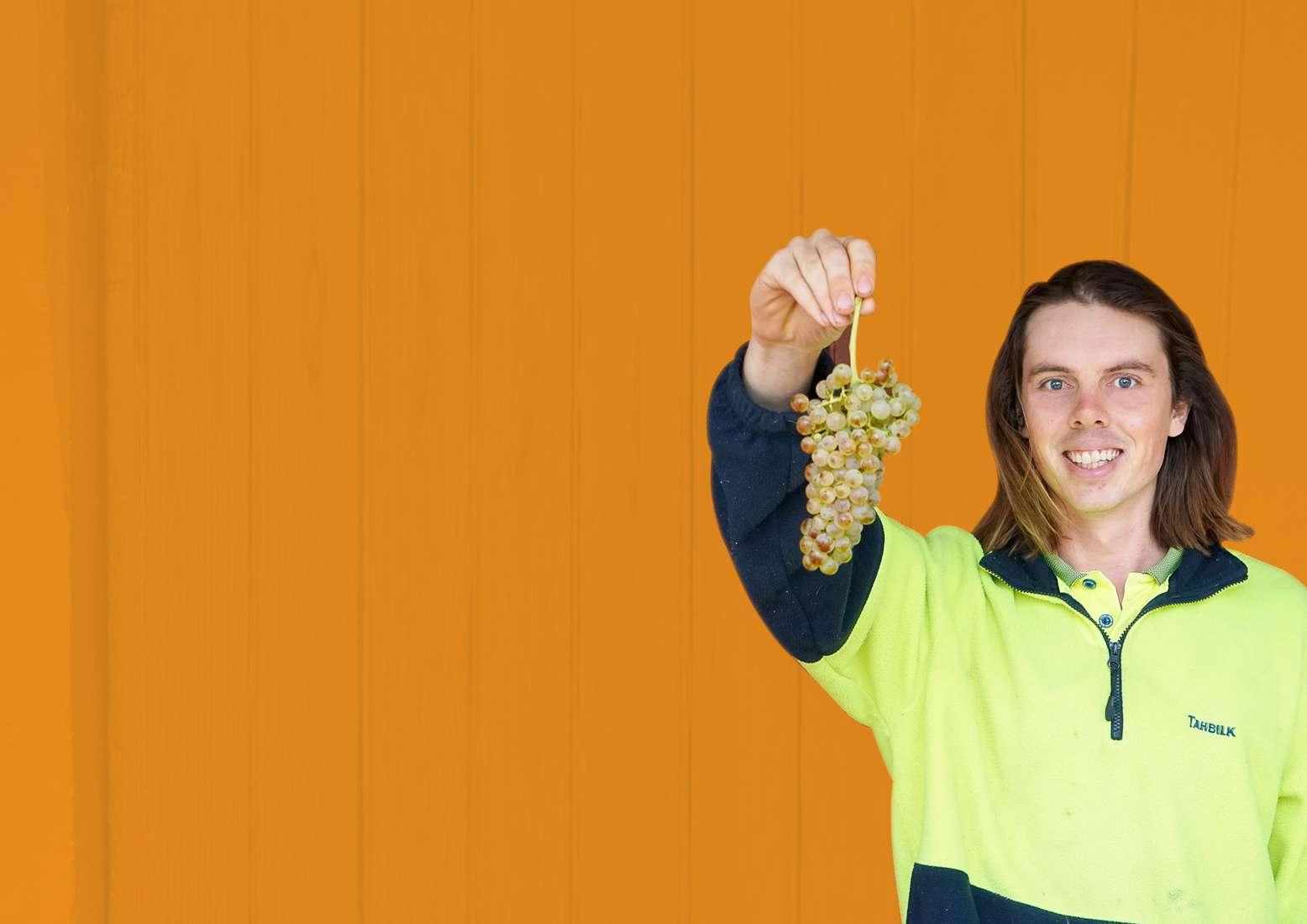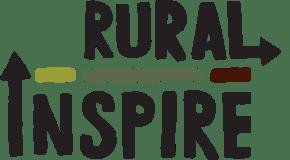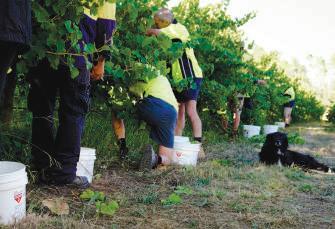Your Job’s Here!
Nagambie Youth Futures Project





We acknowledge the First Nations people on whose traditional lands we meet and work, Taungurung people and pay our respects to their Elders past, present and emerging.

I would like to thank John Beresford, Sissy Hoskin and Professor Jan Carter for the opportunity and significant support in working on this project. To the members of Go Nagambie, thank you for generously providing details and insights into your business and interest in the future of young people in Nagambie region. I am particularly grateful for the insights provided at interviews with Matt Fowles and Georgia Velt (Fowles Wines); Sam Matthews (Swettenham Stud); Peter Johnson (Golden Camel Mining Pty Ltd); Alister Purbrick (Tahbilk Winery); Amy O’Brien (Seymour Health); and Leysa O’Brien (Mitchelton Winery). I would also thank Phil Brown (Country Education Partnership) and Steve Cooper (Strathbogie Shire Council) for their discussion on young people’s opportunities in the Nagambie labour market.
Go Nagambie acknowledges the funding by the Heathcote and Nagambie Community Bendigo Bank for this Youth Futures Project.
Marian Pettit
© Go Nagambie 2022
Apart from fair dealing for the purpose of private study, research, criticism, or review, as permitted under the Copyright Act 1968 and subsequent amendments, no part of this paper may be reproduced by any process without written permission of Go Nagambie (Nagambie Lakes Tourism and Commerce Inc).
Nagambie businesses are transforming the region into a tourism, wine, hospitality and equine centre. Just 90 minutes from Melbourne people are making the ‘tree change’ to Nagambie. The region provides sustainable career opportunities ranging from the highly qualified engineer, winemaker, viticulturist, skilled technical and trades; to health professionals and a diversity of wine/ hospitality pathways. Nagambie businesses however are experiencing significant skill shortages across occupations and industries. Currently, local businesses have over 150 job vacancies and are expecting the local labour market to grow by 25% (or 340 jobs) in the next two years. One third of the workforce is likely to retire in the next 5-10 years.
The opportunities to reap the rewards of economic growth will continue to be constrained by labour shortages – a holistic regional approach is required.
Local businesses share the same employment challenges and potential solutions. But surprisingly, only 13% of local employees are young people (under the age of 25 years). Young people are experiencing limited career opportunities in Nagambie.
Businesses need to capture the attention of local young people before they leave; tap into the influx of young people from the cities to regional Victoria and encourage experienced local people to return to Nagambie. Young people need to be informed and see their aspirations fulfilled by living in Nagambie.
This report presents insights into Nagambie’s labour market and an approach to lifting young peoples’ aspirations to work locally. Given Nagambie has no local secondary school or TAFE, a young people’s enabling organisation(s) and networks are needed to communicate and link young people to local business. Working together across business, schools, TAFE, governments and young people is essential over the longer term. Skills development remains a critical challenge for businesses and young people in Nagambie – linkage to government initiatives such as fee free TAFE places and Rural Inspire Youth Ambassador Program (RIYAP) are timely opportunities.
“We face three challenges in Nagambie. We need people, people, and more people”
Gerry Ryan OAM
Establish regular six monthly collaboration and information sharing forums to discuss labour market challenges and solutions; and create young people employment solutions and integrated career opportunities. Go Nagambie through their business network and the Federal Government funded Rural Inspire Program are best placed to be funded to run these forums.

Go Nagambie and Rural Inspire Youth Ambassador Program (RIYAP) become the link to coordinate the business community, schools and young people to create a “Young people Jobs Map”. A Young People Jobs Map sets out systemic employer engagement with school leavers and wider community. The Jobs Map provides the vision, collective effort, responsibility, KPIs, funding and milestones to:
1. Change the perception and aspirations of young people to live/work in Nagambie region – particularly in the health, wine, equine, mining and hospitality sector.
2. Identify and address young peoples’ challenges, barriers and opportunities to gaining local jobs particularly for disadvantaged young people.
3. Identify the skills shortages in the region – outlining skills requirements across business and sectors.
4. Target employer’s, school’s and tertiary sector’s capacity to address these shortages.
5. Map the career paths within the major industries and employers including the skill and knowledge requirements.
6. Establish strategic industry partnerships such as the wine and hospitality industries to attract young people; buddy scheme for young people, and regional job pathways.
7. Encourage regional secondary schools and the Vocational and Education and Training (VET) sector to support local employment through facilitating career matching for young people at school. This will involve early identification of students who fit with local employers and organising work experience, schoolbased apprenticeships and traineeships and/or visits to local industry.
8. Resource young people orientated organisation (s) focussed specifically on Nagambie region.
9. Collaborate with the Strathbogie and Mitchell Shire Councils – embedding young people’s employment in their Economic Development Strategies and infrastructure considerations.
Develop “Your Job’s Here’ Campaign!” for local young people and parents. A medium term strategy would involve Go Nagambie and RIYAP in:
1. Identifying opportunities and marketing to attract young people to the Nagambie region –either to work and/or live in the region.
2. Developing “Your Job’s Here!’ targeted campaign for Year 10-12 students and parents highlighting careers, types of jobs, skill requirements in Nagambie.

3. Leaving school with generalist skills and how to access jobs that provide on the job skill development, training and short courses and mentoring.
4. Acquiring technical skills and tertiary training –university, college/TAFE for winemaking, equine management, agriculture, project management, business, accountancy and marketing,
5. RIYAP collaborates with schools to foster local opportunities and how to gain jobs – schools ensuring school leavers have the ability and are suitable for local jobs.
6. Developing video case studies of success – former students employed locally, at university or returning to community and multigenerational family employment.
7. Promoting linking of employers to students –jobs showcase in Nagambie, who is employing and what jobs and conversations between employers.
1. To facilitate the Young People Jobs Map and Campaign, Go Nagambie will require additional funding and resources to undertake coordination and delivery over the medium term. The key to success will be specific responsibility and coordination with Federal and Victorian Government (infrastructure, education and training, social services, housing), local employment services; young people, sporting and recreation clubs/ groups; local community and regional groups and communities (Shepparton, Euroa, Seymour, Kilmore), universities and other central Victoria Shire Councils.
Over the past 10 years, the Nagambie region has been growing through the expansion of many local industries and people moving to rural lifestyles away from the cities.
Nagambie is well placed with its proximity to Melbourne, beautiful natural and productive environment. With growing industry and community comes significant long-term employment opportunities across many sectors such as tourism, hospitality, health, wine production, equine and mining. Local businesses are highlighting the need to employ local people, develop the skills within the community and to attract young people to stay or come to Nagambie.
Go Nagambie has responded by initiating the Nagambie Youth Futures Project that seeks to:
• Understand the Nagambie labour market and business requirements and challenges;
• Foster business and young people benefiting from future employment opportunities;

• Support local young people to realise their career aspirations and pathways locally.
To enhance connecting with young people, Go Nagambie has linked with the Rural Inspire Youth
Ambassador Program (RIYAP) to assist in creating awareness of local employment and career opportunities and connecting local businesses and schools. RIYAP is concurrently undertaking the listening to young people; supporting their aspirations and leadership; and facilitating the forums and ways to connect young people to business.
This report provides evidence and recommendations to assist Go Nagambie and RIYAP in developing a regional response to improve young people’s career pathways locally and address skill shortages in the regional labour market. The RIYAP gathered youth voice will feed into the second stage of this project.
This report presents insights into Nagambie’s labour market and an approach to lifting young peoples’ aspirations to work locally. Given Nagambie has no local secondary school or TAFE, a young people’s enabling organisation(s) and networks are needed to communicate and link young people to local business. Working together across business, schools, TAFE, governments and young people is essential over the longer term.
Skills development remains a critical challenge for businesses and young people in Nagambie –linkage to government initiatives such as fee free TAFE places and Rural Inspire Youth Ambassador Program (RIYAP) are timely opportunities.
Over the past 100 years with the improvements in technology and production, employment in agriculture has dramatically declined while employment in the services sector continues to grow (8 out of 10 workers are in the services)i. Australia is experiencing other transformative changes to meet net zero emissions reduction targets by 2050; and impact of digital technology on the provision of goods and services and connectivity. Australia’s ageing workforce also requires business and governments to invest in developing a dynamic, skilled next generation labour market.
A foundation of future prosperity is investing and better utilising of our workforce. The recent National Jobs and Skills Summit points the way with actions to build a bigger, better trained and more productive workforce. Addressing skills shortages and growing our productivity means improving women’s participation and equality in the labour market; and reducing the barriers to employment.ii The Summit’s key take-aways for Nagambie are:
• Additional fee-free TAFE places and mirco-credentials to support work-based learning;
• Support for apprenticeships
• Increase the Permanent Migration program
• Policies to address regional labour shortages and access of small business to skilled migration
• Provision of high-quality, low-cost early education and care
• Changes to the Fair Work Act to create simple, fair and flexible framework
• Solutions to better skill, attract, protect and retain agricultural workers.
Regional Australia is transforming itself through fostering its competitive advantage, looking to future economic opportunities and trends. The changing industries, technology and the environment require significant investment. To achieve this structural change at the local level, the workforce requires skills development, competitive wages and conditions and local infrastructure such as supply of housing, services and transport. Without a collaborative approach opportunity will be lost.
In the past 2 years, a significant trend is city-dwellers moving to the country regions and regional people choosing to stay.iii In particular, the strong investment across a range of regional industries has led to millennials and Gen Xers moving out of the capital cities for life/ work balance and housing affordability1.
There are 5 key aspects promoting the ‘liveability in the country”:
1. Housing affordability
2. Cost of living
3. Health services
4. Community connection
5. Employment opportunities
Regional Victoria’s strong economic growth has absorbed the local skill base; highlighted the disparities in the labour market; and reduced rural migration to the cities. Regional Victoria is experiencing significant increase in job vacancies particularly in professional, technical and trade and community and personnel servicesiv. However, the limited entry level job opportunities for young people, businesses capacity to provide training other than on the job is leading to continuing skill shortages and job vacancies.
With skills shortages continuing, businesses need to invest in new equipment and processes to deliver goods and services.v and expand the pool of employees. Some solutions are to expand take in and training of younger people, people with a disability, First Nations people, unemployed and older workers.
Young people continue to struggle in the labour market. Schools need to look at how better to prepare young people for their lives vi; gain support from parents/carers; and access local networks. Key initiatives are professional career counselling, transitional support and workplace experience which enable young people to realise their aspirations, potential and connection to the labour market.vii Career confusion and limited diversity in vocational learning and employment opportunities can lead to young people being at risk or disconnecting from work; or moving away from home to gain experience and life skills.
To ensure young people are developing the skills, capabilities to thrive requires enabling organisations and networks that are;
• Focussed and collaborative partnerships at the local level involving schools, industry, business, governments, community organisations, community, young people and their families;
• Peer support networks within schools, TAFE, local communitiesviii
In regional Victoria, young people are experiencing a different and changing labour market. Young people may not have casual jobs while at school; limited access to work experience and/or career counselling. Many young people start looking for their first job once they complete school. Young people are facing reduced availability of entry level jobs; reduced opportunity to gain local training to meet local jobs needs; loss of jobs to digital technology and mechanisation and the structural change away from agricultural industries towards service industries. ix
The first stage of this project is about information gathering from local businesses on the Nagambie labour market and the potential opportunities for young people.
The key components of this stage are:
• Go Nagambie employer survey;

• Interviews with 6 key employers representing wine production, hospitality, equine, construction, resources and healthcare2
• A report providing the findings and recommendations from the above.
In July 2022, Go Nagambie sent out a Survey to all business members requesting response to twenty questions relating to their business, employment profile, young people employment and future employment needs. In total, 44 businesses responded3 across a range of industries, business sizes and locations.4 The survey respondents were located in Nagambie, Mitchellstown and Avenel regions in the Shire of Strathbogie; Seymour, Broadford, Tallarook in the Shire of Mitchell and Murchison.
For the purposes of this report, the survey catchment area will be called the Nagambie region and young people are between 15-25 years old.
The Nagambie region is transforming from an agricultural-based economy to a more mixed economy with the rise of the tourism, hospitality, accommodation and service sector. Wine producers have evolved to be vertically integrated businesses with hospitality and/or accommodation arms along with cellar door sales and distribution. The equine/thoroughbred studs are growing in national importance along with increasing mining, health and aged care and manufacturing.
The Go Nagambie employer survey reflects the key local industries with high representation of hospitality and accommodation, agriculture, wine production, tourism and services (see Figure 4.1).
In terms of employment, the top four industries from the survey are the multi-industry businesses6 (43.7%) followed by health and aged care (28.3%), equine (7.3%) and transport (6.0%).
3. However, not all survey respondents completed all 21 questions in the survey. 33 (75%) of surveys were fully completed.
4. This report represents the views of the survey respondents and does not represent of all businesses in the Nagambie region.
5. Business Interviews
6. Multi-industries are vertically businesses providing goods and services such as accommodation, wine production, hospitality, retail, agriculture and tourism.
For the purposes of this report, Nagambie businesses are categorised 46% small businesses (less than 5 employees) and 41% are large businesses (more than 16 employees). Only 13% of businesses in the survey were medium sized (5-15 employees). The smaller businesses generally represent less opportunity for young people unless they are in family businesses and training is limited to on the job.
Age profile
Nagambie’s employee profile reflects the ageing population in Australia. Of the nearly 1,340 staff employed in 44 businesses only 13% of employees (171) were young people (aged 15-25 years old) (Figure 4.2). Teenagers are a very small group (4% or 53 young people) and are mainly employed in equine, multi-industry, health services and hospitality. One third of employees are over 50 years old (431 staff) and are likely to be retiring over the next 10 years. The pipeline of employees is not available to replace retiring staff. Businesses will have to build skills within their business, recruit young people or undertake recruit from outside the Nagambie region.
“We
Nagambie’s occupation profile is dominated by managers followed by administrative staff, sales and labourers (see Figure 4.3). Compared with Victorian occupation profile, Nagambie has a significantly higher proportion of managers in local businesses (20.4%) compared to the Victorian occupation profile (13.5%); significantly higher proportions of labourers and administration staff and half the proportion of professional staff (11%) than Victoria (23.3%), community and personal service workers and lower proportion of technicians and trades and sales staff.x

Technical and Trades
Sales
Professional Manager
Machinery Operator and drivers
Labourer
Community and Personal Services
Administration
Across the occupations employment is usually full-time particularly for managers, professionals and machinery operators and drivers (see Figure 4.4). Part-time work can be found mainly in technical and trades, professional and administration. Casual work is in sales, community and personal services and labourer maybe the only options for young people coming out of school to get jobs. However, the limited career pathways locally could be enticing young people to move elsewhere.
Technical and Trades
Sales
Professional Manager
Machinery Operator and drivers
Labourer
Community and Personal Services Administration
With the surging growth in economic activity in Nagambie; Australia wide skills shortage and low unemployment, local businesses are experiencing difficulty in recruiting and retaining staff. Across the board, businesses are experiencing challenges in recruiting staff. The key reasons cited by businesses were the shortage or lack of skilled and professional workers (29% of responses) followed by lack of applicants (24.1%), rural location (15.5%) and wages and conditions (12.1%). Covid 19 pandemic was only cited twice as a challenge.
Across the region, businesses had a 12% job vacancy rate (150 positions) with a diverse range of skills required from the unskilled to semi-skilled workers to professionals and managers (see Figure 4.5). Businesses stated vacancies in the ‘other’ category were for unskilled workers (such as cleaners, housekeepers, waiters) and skilled/professional staff (such as cooks, mechanics, marketing and engineers). Large multi-industry businesses are experiencing the highest job vacancies (25%) followed by equine (14%), professional services (13%) then accommodation (11%) and hospitality (10%).
Filling job vacancies means changes to recruitment and retention practices of local businesses and looking at collaborative regional efforts (See Figure 4.6). Currently, Nagambie businesses focus on recruiting locally through word of mouth (27.7%) followed by people approaching the business (18.1%) then social media (15%) and on-line sites (14.4%). Only two businesses connected with schools or TAFE to recruit employees. Businesses also reported being unable to attract people from outside the region to jobs. Of particular concern was the limited success in recruiting specialist and/or technical skills such as engineers, winemakers, chefs and managers.
Local businesses reported the major reasons staff moved jobs was for better wages and conditions (27.3%) followed staff relocating (16.4%), their career opportunity (14.6%) and personal and family circumstance (14.6%).
The current jobs challenge gives opportunity to support local young people to start their career as technicians and trades, administration and machinery operators. The high vacancies in managers may result from local businesses not being as competitive in the Victorian labour market and local businesses not being able grow and retain local talent or articulate a regional career pathway.
“Students drive the work placements –we wan’t to establish better connections with education providers and employers”
Lee Rowland - President, Go Nagambie
Over 150 vacant jobs now
Skills needed unskilled, professionals, managers, machinery operators, drivers and administration
Only 13% of young people in jobs
Without employment opportunities, young people will leave town and are unlikely to return. Their connection to the local Nagambie labour market is limited by young people going to secondary school in the regional towns such as Seymour, Kilmore and Shepparton; and variable access to local work experience and casual jobs. Young people leaving school need to be inspired through their schools, parents and businesses to take up the local opportunities or they will be attracted by training or jobs elsewhere. The pathway of returning locals is not clear and would boost the skill and experience pool in Nagambie.


In total, 171 young people were employed in 22 businesses. In the last 2 years, 75% of businesses stated they had recruited young people. The larger businesses employ 90% of young people such as health services, multi-industry businesses, hospitality, accommodation and agriculture (See Figure 5.1 and 5.2). The employment prospects for teenagers are very low (only 4% of the Nagambie workforce) and concentrated in four - multi-industry businesses, agriculture, health and aged care and hospitality. Businesses tend to employ people in their twenties with more significant numbers in multi-industry businesses, health and aged care, accommodation and agriculture.
Businesses are looking for over 330 employees in the next 2 years – a 25% increase in the workforce. Here is the opportunity to grow the entry-level jobs and training for young people.

From the Go Nagambie survey, the future job opportunities for young people are in multi-industry businesses (48%) followed by health and aged care (16%), mining (9%) and hospitality and equine (6%) (see Figure 6.1). The occupations sought are managers (15%) and other (15%), professional (13.2%), sales (13.2%) and technicians and trades (11.7%). Of these top five occupations only two sales and other do not require further education and work experience. Professionals and technicians and trades require tertiary qualifications that are obtained outside the region. (See Appendix B) and managers are the product of good career pathways.



“We can change the dynamic for young people with support”
Alister Purbrick - Tahbilk Wines
Businesses’ skill requirements are within reach of young people if given the opportunity. Nagambie businesses seem to be restricting young people from participating in the local labour market. The entry-level jobs are not there and clear, articulated career pathways are not evident to local young people.
Few businesses stated they required VCE completion for jobs. The important skills were around communication, ability to work in a team, selfmotivation and commitment to learn and work. The requirement for VCE, TAFE and tertiary qualifications is job specific such as professional services, chefs, health and aged care, and wine production. In sales, administration, community and personnel services, machinery and drivers and other positions, businesses provide skills and knowledge on the job.
Local businesses report their skill development is around in-house training and mentoring on the job for employees. Less than 50% of businesses were prepared to support traineeships, apprenticeships or school-based apprenticeship, and even less were prepared to support young people going to TAFE courses while employed in the business.
If businesses continue with current employment practices, skills shortages will remain and economic opportunity lost. The Go Nagambie business survey and interviews supports a regional effort to link young people with business as the jobs are un-skilled to semi-skilled entry level. Businesses are prepared to provide on the job training and mentoring to enable the employee to successfully work. However, many businesses do not have the human resource personnel to undertake larger scale activities such as linking with schools and TAFE organisations, providing work experience, traineeships or apprenticeships or be competitive with wages and conditions in Melbourne.
Feedback is that schools and TAFE do not reach out to local businesses. The secondary schools being away from Nagambie means employers to not have the time nor financial capacity to regularly link with schools or TAFE institutions.
The key stakeholders and influences in driving greater young people employment are the larger diverse employers, RIYAP, schools and TAFE organisations, parents and the local Shire Councils along with Go Nagambie. (See Figure 6.2). The many opportunities as articulated by the key case studies is in innovative, jobs for life and hotspots of experience (Appendix B).
Long term solutions to key structural issues in the local labour market centre around young people. Some key strategies to consider are:
• Communicating the diversity local labour market within the region to young people, schools and parents;
• Local business collaborating with RIYAP and schools to ensure young people are job ready when leaving school and understand their career pathways within the region;
• Addressing the skills requirements through local businesses tapping into Government initiatives (ie fee free TAFE courses for staff and micro-credentials);
• Articulating career pathways within the region to ensure local people are not lost to the region due to wages and conditions, relocating for better career opportunities as the pathways to manager, skilled, professional jobs are here;
Shire Councils State and Federal Government
Go Nagambie Businesses
Parent Carers
Rural Inspire Program
Schools, TAFE, training providers
“Hospitality is transient - our constant challenge is finding people that want to stay and build a career”
Matt Fowles
Note: Multi-industry business in the survey were vertically integrated businesses with combinations of viticulture, wine production, accommodation, hospitality, agriculture, manufacturing, retail and tourism.
Victoria’s new gold producer Golden Camel Mining is constructing a processing facility in Nagambie. Golden Camel’s operation spans construction to processing to sustainable waste management. A potential 80 jobs will be created in Central Victoria including up to 24 positions at the Nagambie facility. The processing facility will have state of the art technologies and renewable energy.
Gold mining has changed. Local jobs now range from labourers, security guards, processing staff, electric truck drivers to environmental remediation workers along with OH&S, administration and training jobs for both women and men. No prior experience in gold mining is required as Golden Camel will be providing on the job training and professional development opportunities.
Local young people seeking an outdoor lifestyle and variety in their job should consider gold mining. To get a job requires basic English, ability to work in a team, self-motivation and being safety conscious. A young person’s life experience or previous work experience such as retail, hospitality or farming are skills and knowledge that translate to mining. School leavers, young people having a gap year can aspire to fill these jobs.
Golden Camel also has jobs in technical mining and engineering that require tertiary qualifications and experience. These jobs will attract people to the Nagambie region or locals who wish to return after university or working in mining elsewhere.

The Nagambie region is considered the Thoroughbred breeding centre for Victoria with 6 stud farms in the region including Swettenham, Yulong and Godolphin studs. Horse studs are global businesses that can be family owned or multi-national organisations. Locally studs employ over 250 staff mainly from outside the region or international. At present, studs are seeking farm workers, handlers and managers. Over the medium term the equine industry is expected to double employment.
Young people choose to work in the equine industry for life as it provides a career, good pay, lifestyle and opportunity. Career pathways can start with young people being labourers moving to brood mare/stallion handlers to stable managers to stud managers. Relevant entry-level skills and knowledge are growing up on a farm, working with animals or horse-riding experience. The studs provide on the job training and causal/seasonal work (August – December).
Nagambie boasts fully integrated wine and hospitality businesses with renown wineries such as Tahbilk, Fowles and Mitchelton. Over 25 wineries are located in the Strathbogie Ranges and Goulburn Valley wine regions providing over 750 jobs. Winery tourism is growing, especially from Melbourne supporting an increase by 25-50% in jobs over the next 2 years.
Young people can gain jobs and experience in environmental sustainability, wine production, catering and kitchen, marketing and sales, finance and administration. Wineries are looking for young people with communication skills, ability to work in a team and commitment to learn and work. The career potential is evident where young people can start in a restaurant, cellar door or vineyard and progress into manager positions within the one business or across the region. Jobs are full-time, part-time or casual/seasonal with skills gained on the job and/or through professional development.
The wine and hospitality businesses also provide jobs requiring skilled, technical, trade and tertiary qualifications such as winemakers, viticulturists, bottling and packaging managers and chefs. These jobs are usually filled by people coming to Nagambie for the job and lifestyle. There are also good stories of local people returning to Nagambie.
Health and aged care services provide opportunities for young people that start at school with work experience and school-based apprenticeships and traineeships.

Around 10% of jobs in the Nagambie region are in health and aged care employing doctors, nurses, physios, OTs, personal care, coordinators, cleaners and catering.
Qualifications can be gained through local TAFE and career paths developed through further study or young people going away to study and returning. Jobs will always be available and expanding, for example Seymour Health will have additional surgery facilities and aged care beds.

Rural Inspire is a national program aimed at inspiring young people across rural and remote Australia to chase and realise their dreams – often restricted by the opportunities and information they are provided within their local rural communities.

A key element of the Rural Inspire initiative is the “Rural Youth Ambassador Program” – a program designed to support rural and remote young people to have an impact on improving the life and education within their communities. It was recognised as best practice with the 2019 Commonwealth Governments review of Regional and Rural Education and is now operating in every state and territory of Australia.
With the high success and impact of the program at a state and national level, the Rural Inspire initiative has developed the Local Rural Youth Ambassador Program to work with local rural/remote communities in lifting the aspirations of young people within them – whether that be higher education, employment, or training. A number of these local initiatives are operating across rural communities in partnership with schools, community groups and industry.
The focus of the Local Rural Youth Ambassadors is to engage with young people within an identified rural community to explore their learning and after school aspirations and to encourage them to chase their dreams through the development of locally determined initiatives and programs.
Rural Inspire has gained resources from various levels of government to further develop the Local Rural Youth Ambassadors program across a number of rural and remote communities.
After discussions with representatives of Go Nagambie, and their desire to look at ways in which young people within the Nagambie community could see the employment opportunities that exist within it, a partnership between Rural Inspire and Go Nagambie has been established. Rural Inspire are working in collaboration with Go Nagambie to increase the awareness of young people of the career journey opportunities that exist within their community and facilitate the establishment of partnerships between these young people and local industries to inspire young people to undertake employment within their local
community.
Focusing on engaging with young people, the partnership will explore the current aspirations of young people within the Nagambie area and what their perceptions of the employment opportunities that are available to them in their local community.
It will also partner with Go Nagambie and the work they are currently undertaking in relation to the employment opportunities within the various, and growing, industries that exist within the Nagambie.
Through this exciting partnership it is expected that the young people will be able to work in collaboration with the industries and organisations of Nagambie to develop ideas and initiatives that focus on catering for the growing employment requirements of the Nagambie community.
Phil Brown Rural Inspire Project Manager- Establishment of a small group of 20 young poeple - involvement of both school and non school young people
- Engagement with local schools
- Aseries of workshops and forums to explore youth aspirations within Nagambie and young peoples understanding of the employment and career opportunites that exist within Nagambie
- Exploration of youth aspirations of Nagambie young people
- Consideration and exploration of employment and career options within Nagambie
- Development of ideas to increase the aspiations of young people in partnership with industry
- Engagement of a consultant to undertake a research into local industry employment needs
- Documentation of the outcomes of the research
- Link with industry and community organisation to gain interest and support for the future
- Sharing the outcomes of the research with the Nagambie Youth Aspirations
• Rural Inspire to facilitate a group of up to 20 Nagambie young people to form the Nagambie Youth Ambassadors
• Rural Inspire to utilise its education networks to engage them in identifying possible young people to be involved. The following focus include:
o Primary focus on Euroa Secondary College, Seymour College and Assumption College
o Secondary focus on the schools within Shepparton
• Rural Inspire to support the involvement of non-school based young people.
• The program commenced in August 2022 within the overall framework:
o Exploration of current experiences and reflections that the Rural Youth Ambassadors have in relation to their aspirations and their understanding of the employment opportunities within Nagambie.
o Exploring the positives and challenges within Nagambie, the Rural Youth Ambassadors will share their individual experiences and knowledge and begin to explore possible ideas for the future.
o Development of ideas and activities that will assist with addressing the challenges identified
o Meet with key people who have a great knowledge of the employment and career opportunities within Nagambie.
o In partnership with Go Nagambie, establish initiatives that they, as a group, believe will increase the aspirations and knowledge of opportunities.
The overall program would focus on the following key areas:
- The researchers present the industry research outcomes to the Nagambie Rural Youth Ambassadors
- Nagambie Rural Youth Ambassadors work with Go Nagambie to facilitate a workshop with key industry personnel and other key staekholders to explore the potential initiatives that could be developed into the future
- Go Nagambie explores ways in which the ideas can be implemented in partnership with the Nagambie Rural Youth Ambassadors
- Go Nagambie explores the development of an ongoing approach to engaging young people within their work.
• Aspirations and Dreams – what is my future, what is hindering me getting there, etc.
• Knowledge – what are the employment and career opportunities within Nagambie, what could be improved, and what ideas have we got to enhance our knowledge and support the realisation of our dreams
• Opportunities – what are the opportunities for us within Nagambie, how can local industry work with us in increasing our understanding of the opportunities that are within our community.
• Exploration of strategies and ideas that will increase young peoples opportunities within Nagambie and the potential career journeys possibilities.
• The program would focus on Year 10 and Year 11 students who reside in the Nagambie area
• The engagement of young people who are not involved in schooling will be included in the program.
Industry Jobs In-house TAFE Diploma or Higher
i. Woods D (2022) Thinking big: a new mission statement for Australia, Grattan Institute accessed https://grattan.edu.au/news/think-big-a-new-mission-statement-for-australia/, p
ii. Treasury (2022) Jobs and Skills Summit September 2022 – Outcomes, Australian Government accessed through https://treasury.gov.au/sites/default/files/inline-files/Jobs-and-SkillsSummit-Out comes-Document.pdf
iii. Regional Australia Institute (2021) Building the Good Life: Meeting the demand for regional housing, RAI Discussion Paper.
iv. Regional Australia Institute (2022) Job Vacancy report accessed https://www.regionalaustralia.org.au/Web/Shared_Content/Smart-Suite/Smart-Library/Public/Smart-Library-Search. aspx?hkey=a1cd6985-7c60-47fe-8eaa-51963aa2bfac
v. Woods D (2022) Thinking big: a new mission statement for Australia, Grattan Institute accessed https://grattan.edu.au/news/think-big-a-new-mission-statement-for-australia/
vi. Mann A, Denis V Schleicher A, Ekhtiari H, Forsyth,T, Liu E and Chambers, N (2022) Dream Jobs ?: Teenages’ Career Aspirations and the Future of Work, OECD, www.oecd.org.au
vii. Youth Pathway Action Plan Taskforce (2001) Footprints to the Future, Australian Government.
viii. Bond, S & Keys, D 2020, Finding that spark: what works to achieve effective employment services for young people?, Brotherhood of St Laurence, Fitzroy, Vic.
ix. Regional Australia Institute (2019) Submission to the Senate Select Committee Inquiry into the jobs for the future in regional Australia ac https://www.regionalaustralia.org.au/Web/ Shared_Content/Smart-Suite/Smart-Library/Public/Smart-Library-Search.aspx?hkey=a1cd69 85-7c60-47fe-8eaa-51963aa2bfac cess
x. ABS Census Data 2016: Strathbogie Shire and Victorian labour market profile access from https://profile.id.com.au/australia/occupations?WebID=110
For further information: Go Nagambie Executive Officer - Sissy Hoskin executiveofficernltc@gmail.com

Rural Inspire Project Manager - Phil Brown phil@cep.org.au




